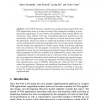Free Online Productivity Tools
i2Speak
i2Symbol
i2OCR
iTex2Img
iWeb2Print
iWeb2Shot
i2Type
iPdf2Split
iPdf2Merge
i2Bopomofo
i2Arabic
i2Style
i2Image
i2PDF
iLatex2Rtf
Sci2ools
ICWE
2005
Springer
2005
Springer
The Role of Visual Tools in a Web Application Design and Verification Framework: A Visual Notation for LTL Formulae
As the Web becomes a platform for implementing complex B2C and B2B applications, there is a need to extend Web conceptual modeling to process-centric applications. In this context, new problems about process safety and verification arise. Recent work has investigated high-level specification and verification of Web applications. This relies on a formal data-driven model of the application, which can access an underlying database as well as state information updated as the interaction progresses, and a set of user inputs. Properties verified concern the sequences of events, inputs, states, and actions resulting from the interaction. For the purpose of automatic verification, properties are expressed in linear-time or branching-time temporal logics. However, temporal logics properties are difficult to specify and understand by users, which can be a significant obstacle to the practical use of verification tools. In the present paper, we propose two alternative visual notations for specif...
| Added | 27 Jun 2010 |
| Updated | 27 Jun 2010 |
| Type | Conference |
| Year | 2005 |
| Where | ICWE |
| Authors | Marco Brambilla, Alin Deutsch, Liying Sui, Victor Vianu |
Comments (0)

